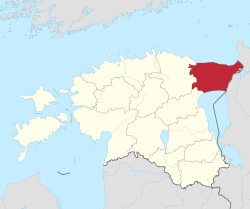Top Qs
Timeline
Chat
Perspective
Ida-Viru County
County in northeastern Estonia From Wikipedia, the free encyclopedia
Remove ads
Ida-Viru County (Estonian: Ida-Viru maakond or Ida-Virumaa; Russian: Ида-Вируский уезд, romanized: Ida-Viruskij uezd) is one of the 15 counties of Estonia. It is the most northeastern part of the country. The county contains large deposits of oil shale – the main mineral mined in Estonia. Oil shale is used in the production of shale oil and in thermal power plants. The capital of the county is the town of Jõhvi which is administratively united with the Jõhvi Parish; nevertheless, Narva is the largest town in the county in terms of population and at the same time the third largest city in Estonia after Tallinn and Tartu.
In January 2019 Ida-Viru County had a population of 136,240 – constituting 10.3% of the total population in Estonia.[1][3] It borders Lääne-Viru County in the west, Jõgeva County in the southwest and Russia (Leningrad Oblast) in the east. It is the only county in Estonia where Russians constitute the majority of population (73.1% in 2010), the second highest being Harju (28%).
Remove ads
History
During the latter part of the period of Soviet rule of Estonia, Ida-Virumaa was called Kohtla-Järve district, and its administrative capital was Kohtla-Järve.
County Government (Estonian: maavalitsus), led by a governor (Estonian: maavanem), ceased to exist after administrative reform in 2017. The last governor of Ida-Viru county was Andres Noormägi.[4]
Demographics

In January 2017, the population of Ida-Virumaa was 143,880, which makes it the third largest county in Estonia (after Harju and Tartu counties, which include the capital Tallinn and country's second-largest city Tartu). 44.6% of the population are men and 55.4% women.[3]
By January 2020, the population of Ida-Virumaa had decreased to 134,259, of which 33% were of native origin and 67% of foreign origin.[5]
As a result of migration, Ida-Viru County is now the only county in Estonia where ethnic Russians have become a majority.
By ethnic origin, on 1 January 2017, 73.1% of the population were Russians, 18.9% were Estonians, 2.3% were Ukrainians, 2.1% were Belarusians and 0.9% were Finns.[3]
According to Estonian 2021 census population of Ida-Virumaa was 132,741. By ethnic origin 97,231 (73.25%) were Russians, 24,490 (18.45%) were Estonians, 3,265 (2.46%) Ukrainians, 2,720 (2.05%) were Belarusians, and 1,065 (0.80%) were Finns. Estonians are predominant in the more rural parishes to the west of country - Alutaguse (69.47%), Toila (64.27%) and Lüganuse (55.07%)[6]
Remove ads
Religion
Summarize
Perspective
The following congregations of the Estonian Evangelical Lutheran Church (EELC) operate in Ida-Viru County under Viru Deanery of EELC: Iisaku congregation, Illaku congregation, Jõhvi congregation, Lüganuse congregation, Narva congregation, Narva-Jõesuu congregation, Pühajõe congregation and Tudulinna congregation.[7]
Regarding Eastern Orthodoxy, the following Orthodox congregations operate under the jurisdiction of the Estonian Orthodox Church of the Moscow Patriarchate: Alajõe, Jaama, Jõhvi, Kiviõli, Kohtla-Järve, Lohusuu, Vasknarva, the congregation of the Narva Cathedral of the Resurrection of Christ and three other Orthodox parishes in the city of Narva and two congregations in Narva-Jõesuu.[8]
A Russian Orthodox convent - Pühtitsa Convent is located in Ida-Viru County.
The congregations belonging to the Catholic Church in Estonia that operate in Ida-Viru County are: Ahtme, Narva, Sillamäe, Kiviõli and Sompa and Kohtla-Järve.[9]
Baptist congregations operating in Ida-Viru County: Kiviõli, Sillamäe, four congregations in the city of Kohtla-Järve and two congregations in Narva.[10]
Of the other Christian churches, there are four Methodist congregations,[11] one Pentecostal congregation,[12] two Adventist congregations and one Jehovah's Witnesses congregation.
Remove ads
Municipalities
Ida-Virumaa County is subdivided into eight municipalities, of which four are urban (Estonian: linnad — cities or towns) and four are rural (Estonian: vallad — parishes). There are 217 villages in Ida-Virumaa.

Remove ads
Landmarks
References
External links
Wikiwand - on
Seamless Wikipedia browsing. On steroids.
Remove ads












